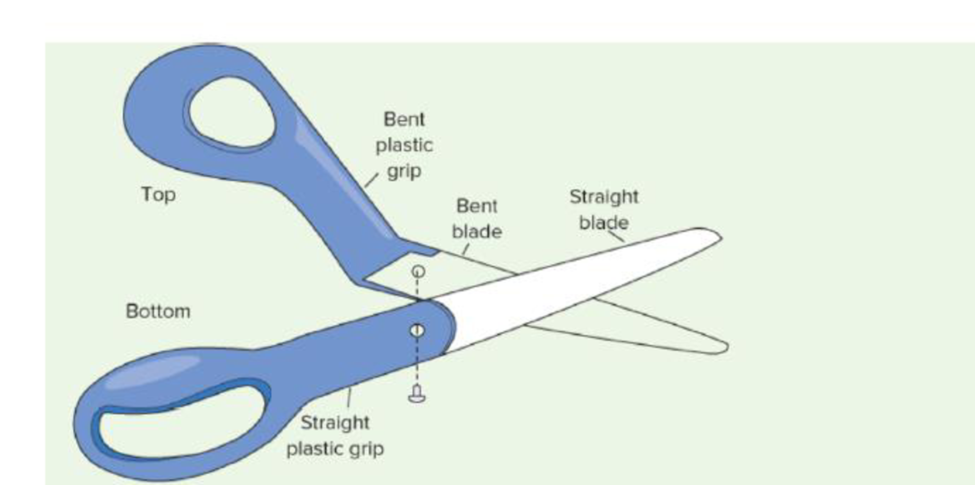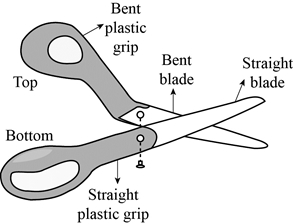
Concept explainers
Using the accompanying diagram, do the following:
a. Draw a tree diagram for the scissors.
b. Prepare an MRP plan for scissors. Lead times are one day for each component and final scissor assembly, but two days for the plastic grips. Six hundred pairs of scissors are needed on day 6. Note: There are 200 straight blades and 350 bent blades on hand, and 40 top blade assemblies on hand.
Use lot-for-lot ordering for all items.

a)
To prepare: Tree diagram for the scissors.
Introduction: Materials Requirement Planning (MRP) is the planning or scheduling system, which can be used in the manufacturing process. It is used to plan the number of items required to produce one unit of finished goods (end item).
Explanation of Solution
Given information:
Lead-time is one day for all the components except plastic grips, which has the lead-time of 2 days. 600 pairs of scissors are needed on day 6. There are 350 bent blades, 200 straight blades, and 40 top blade assemblies on hand. Lot size is lot-for-lot ordering for all items.
In addition to that, following diagram is given:

Prepare tree diagram for the scissors using given diagram:

b)
To prepare: A Material requirement planning for scissors.
Introduction: Materials Requirement Planning (MRP) is the planning or scheduling system, which can be used in the manufacturing process. It is used to plan the number of items required to produce one unit of finished goods (end item).
Explanation of Solution
Given information:
Lead-time is one day for all the components except plastic grips, which has the lead-time of 2 days. 600 pairs of scissors are needed on day 6. There are 350 bent blades, 200 straight blades, and 40 top blade assemblies on hand. Lot size is lot-for-lot ordering for all items.
In addition to that, following diagram is given:

Develop material requirement planning for scissors:

- It is given that 600 pairs of scissors are needed on day 6.
- Beginning inventory is 0 units.
- Net requirement can be calculated by subtracting the projected on-hand from the gross requirement. Hence, the net requirement is 600 units in week 6 (600-0).
- Planned order release is the order given by the company and planned order receipts is the order received by the firm.
- Lead-time is given as 1 week. Company requires 600 units in the beginning of Week 6. Hence, they need to order for 600 units (as the lot size is lot-for-lot) on previous week (as the lead-time is 1 week). Thus, company need to order the required units in week 5.
Develop material requirement planning for bottom blade assembly:

- Scissor is the parent for bottom blade assembly. Hence, the planned order release of the scissor would be the gross requirement of the bottom blade assembly. As number of units required is 1 for bottom blade assembly, the planned order release row of scissor should be multiplied with 1 to attain the gross requirement column of bottom blade assembly.
- Beginning inventory is 0 units.
- Net requirement can be calculated by subtracting the projected on-hand from the gross requirement. Hence, the net requirement is 600 units in week 5(600-0).
- Planned order release is the order given by the company and planned order receipts is the order received by the firm.
- Lead-time is given as 1 week. Company requires 600 units in the beginning of Week 5. Hence, they need to order for 600 units (as the lot size is lot-for-lot) on previous week (as the lead-time is 1 week). Thus, company need to order the required units in week 4.
Develop material requirement planning for top blade assembly:

- Scissor is the parent for top blade assembly. Hence, the planned order release of the scissor would be the gross requirement of the top blade assembly. As number of units required is 1 for top blade assembly, the planned order release row of scissor should be multiplied with 1 to attain the gross requirement column of top blade assembly.
- Beginning inventory is 40 units.
- Net requirement can be calculated by subtracting the projected on-hand from the gross requirement. Hence, the net requirement is 560 units in week 5 (600-40).
- Planned order release is the order given by the company and planned order receipts is the order received by the firm.
- Lead-time is given as 1 week. Company requires 560 units in the beginning of Week 5. Hence, they need to order for 560 units (as the lot size is lot-for-lot) on previous week (as the lead-time is 1 week). Thus, company need to order the required units in week 4.
- Projected on hand inventory for week 6 is 0 units. Calculation is as follows:
Develop material requirement planning for screw:

- Scissor is the parent for screw. Hence, the planned order release of the scissor would be the gross requirement of the screw. As number of units required is 1 for screw, the planned order release row of scissor should be multiplied with 1 to attain the gross requirement column of screw.
- Beginning inventory is 0 units.
- Net requirement can be calculated by subtracting the projected on-hand from the gross requirement. Hence, the net requirement is 600 units in week 5 (600-0).
- Planned order release is the order given by the company and planned order receipts is the order received by the firm.
- Lead-time is given as 1 week. Company requires 600 units in the beginning of Week 5. Hence, they need to order for 600 units (as the lot size is lot-for-lot) on previous week (as the lead-time is 1 week). Thus, company need to order the required units in week 4.
Develop material requirement planning for straight blade:

- Bottom blade assembly is the parent for straight blade. Hence, the planned order release of the bottom blade assembly would be the gross requirement of the straight blade. As number of units required is 1 for straight blade, the planned order release row of bottom blade assembly should be multiplied with 1 to attain the gross requirement column of straight blade.
- Beginning inventory is 200 units.
- Net requirement can be calculated by subtracting the projected on-hand from the gross requirement. Hence, the net requirement is 400 units in week 4(600-200).
- Planned order release is the order given by the company and planned order receipts is the order received by the firm.
- Lead-time is given as 1 week. Company requires 400 units in the beginning of Week 4. Hence, they need to order for 400 units (as the lot size is lot-for-lot) on previous week (as the lead-time is 1 week). Thus, company need to order the required units in week 3.
- Projected on hand inventory for week 5 is 0 units. Calculation is as follows:
Develop material requirement planning for straight plastic grip:

- Bottom blade assembly is the parent for straight blade. Hence, the planned order release of the bottom blade assembly would be the gross requirement of the straight blade. As number of units required is 1 for straight blade, the planned order release row of bottom blade assembly should be multiplied with 1 to attain the gross requirement column of straight blade.
- Beginning inventory is 0 units.
- Net requirement can be calculated by subtracting the projected on-hand from the gross requirement. Hence, the net requirement is 600 units in week 4 (600-0).
- Planned order release is the order given by the company and planned order receipts is the order received by the firm.
- Lead-time is given as 2 weeks. Company requires 600 units in the beginning of Week 4. Hence, they need to order for 600 units (as the lot size is lot-for-lot) before two weeks (as the lead-time is 2 weeks). Thus, company need to order the required units in week 3.
Develop material requirement planning for bent blade:

- Top blade assembly is the parent for bent blade. Hence, the planned order release of the top blade assembly would be the gross requirement of the bent blade. As number of units required is 1 for bent blade, the planned order release row of top blade assembly should be multiplied with 1 to attain the gross requirement column of bent blade.
- Beginning inventory is 350 units.
- Net requirement can be calculated by subtracting the projected on-hand from the gross requirement. Hence, the net requirement is 210 units in week 4 (560-350).
- Planned order release is the order given by the company and planned order receipts is the order received by the firm.
- Lead-time is given as 1 week. Company requires 210 units in the beginning of Week 4. Hence, they need to order for 210 units (as the lot size is lot-for-lot) on previous week (as the lead-time is 1 week). Thus, company need to order the required units in week 3.
- Projected on hand inventory for week 5 is 0 units. Calculation is as follows:
Develop material requirement planning for bent plastic grip:

- Top blade assembly is the parent for bent plastic grip. Hence, the planned order release of the top blade assembly would be the gross requirement of the bent plastic grip. As number of units required is 1 for bent plastic grip, the planned order release row of top blade assembly should be multiplied with 1 to attain the gross requirement column of bent plastic grip.
- Beginning inventory is 0 units.
- Net requirement can be calculated by subtracting the projected on-hand from the gross requirement. Hence, the net requirement is 560 units in week 4 (560-0).
- Planned order release is the order given by the company and planned order receipts is the order received by the firm.
- Lead-time is given as 1 week. Company requires 560 units in the beginning of Week 4. Hence, they need to order for 560 units (as the lot size is lot-for-lot) on previous week (as the lead-time is 1 week). Thus, company need to order the required units in week 3
Want to see more full solutions like this?
Chapter 12 Solutions
Operations Management (Comp. Instructor's Edition)
Additional Business Textbook Solutions
Operations Management: Processes and Supply Chains (12th Edition) (What's New in Operations Management)
Gitman: Principl Manageri Finance_15 (15th Edition) (What's New in Finance)
Principles of Operations Management: Sustainability and Supply Chain Management (10th Edition)
Principles Of Taxation For Business And Investment Planning 2020 Edition
FUNDAMENTALS OF CORPORATE FINANCE
Financial Accounting, Student Value Edition (5th Edition)
- Prepare a graph of the monthly forecasts and average forecast demand for Chicago Paint Corp., a manufacturer of specialized paint for artists. Compute the demand per day for each month (round your responses to one decimal place). Month B Production Days Demand Forecast Demand per Day January 21 950 February 19 1,150 March 21 1,150 April 20 1,250 May 23 1,200 June 22 1,000' July 20 1,350 August 21 1,250 September 21 1,050 October 21 1,050 November 21 December 225 950 19 850arrow_forwardThe president of Hill Enterprises, Terri Hill, projects the firm's aggregate demand requirements over the next 8 months as follows: 2,300 January 1,500 May February 1,700 June 2,100 March April 1,700 1,700 July August 1,900 1,500 Her operations manager is considering a new plan, which begins in January with 200 units of inventory on hand. Stockout cost of lost sales is $125 per unit. Inventory holding cost is $25 per unit per month. Ignore any idle-time costs. The plan is called plan C. Plan C: Keep a stable workforce by maintaining a constant production rate equal to the average gross requirements excluding initial inventory and allow varying inventory levels. Conduct your analysis for January through August. The average monthly demand requirement = units. (Enter your response as a whole number.) In order to arrive at the costs, first compute the ending inventory and stockout units for each month by filling in the table below (enter your responses as whole numbers). Ending E Period…arrow_forwardMention four early warning indicators that a business may be at risk.arrow_forward
- 1. Define risk management and explain its importance in a small business. 2. Describe three types of risks commonly faced by entrepreneurs. 3. Explain the purpose of a risk register. 4. List and briefly describe four risk response strategies. (5 marks) (6 marks) (4 marks) (8 marks) 5. Explain how social media can pose a risk to small businesses. (5 marks) 6. Identify and describe any four hazard-based risks. (8 marks) 7. Mention four early warning indicators that a business may be at risk. (4 marks)arrow_forwardState whether each of the following statements is TRUE or FALSE. 1. Risk management involves identifying, analysing, and mitigating risks. 2. Hazard risks include interest rate fluctuations. 3. Entrepreneurs should avoid all forms of risks. 4. SWOT analysis is a tool for risk identification. 5. Scenario building helps visualise risk responses. 6. Risk appetite defines how much risk an organisation is willing to accept. 7. Diversification is a risk reduction strategy. 8. A risk management framework must align with business goals. 9. Political risk is only relevant in unstable countries. 10. All risks can be eliminated through insurance.arrow_forward9. A hazard-based risk includes A. Political instability B. Ergonomic issues C. Market demand D. Taxation changesarrow_forward
 Contemporary MarketingMarketingISBN:9780357033777Author:Louis E. Boone, David L. KurtzPublisher:Cengage Learning
Contemporary MarketingMarketingISBN:9780357033777Author:Louis E. Boone, David L. KurtzPublisher:Cengage Learning Practical Management ScienceOperations ManagementISBN:9781337406659Author:WINSTON, Wayne L.Publisher:Cengage,MarketingMarketingISBN:9780357033791Author:Pride, William MPublisher:South Western Educational Publishing
Practical Management ScienceOperations ManagementISBN:9781337406659Author:WINSTON, Wayne L.Publisher:Cengage,MarketingMarketingISBN:9780357033791Author:Pride, William MPublisher:South Western Educational Publishing Purchasing and Supply Chain ManagementOperations ManagementISBN:9781285869681Author:Robert M. Monczka, Robert B. Handfield, Larry C. Giunipero, James L. PattersonPublisher:Cengage Learning
Purchasing and Supply Chain ManagementOperations ManagementISBN:9781285869681Author:Robert M. Monczka, Robert B. Handfield, Larry C. Giunipero, James L. PattersonPublisher:Cengage Learning




